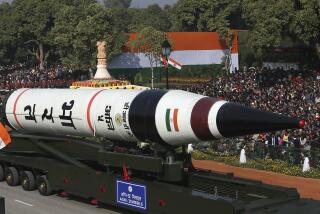Battling an Illusion While Missing a Threat
- Share via
Now that the dust has settled at the Indian and Pakistani test sites, some conservative politicians and pundits are issuing an eerily consistent reaction: Missile defense, good. Test ban, bad. Although this refrain may be politically convenient, it will not solve the real security threats facing the United States and the world.
Many are using these recent global events and their profound implications for U.S. security to “spin” their own political agenda. How else to interpret the gallons of ink that have been spilled on op-ed pages calling for the deployment of a national ballistic missile defense in response to South Asian nuclear tests and missile developments? Although it may seem that there is a logical link between these two concepts, think again.
First, the facts. It is indeed scary that India and Pakistan have blown their way into the nuclear club and that both are developing ballistic missiles that, with nuclear warheads aboard, could kill millions of people. A nuclear arms race or war in South Asia would have grave consequences for the region and could pull the United States into its wake. We should work hard to defuse the current crisis and seek to prevent additional nuclear testing, nuclear material production and missile deployments.
This will require an effective strategy of U.S. engagement with South Asia and our allies. “Fortress America” is not a rational response to this situation. Yet that is all the conservative camp has to offer. Rather than address the problems in South Asia, these people want to build missile defenses in the U.S. Nevermind that India and Pakistan are more than 5,000 miles away and their missiles can only travel 1,000 miles. Never mind that neither nation would ever dream of attacking the United States even if they could.
When one pushes this point, missile defense enthusiasts switch tacks and start talking about other missiles in hostile nations. Those so-called “rogue” countries are also thousands of miles away, and none of them--including North Korea--deploys missiles with a range greater than 400-600 miles.
What about the possibility that new missile threats may pop up and surprise us? U.S. intelligence missed the Indian nuclear tests, right? Not really. The major Indian test preparations were in fact discovered by U.S. intelligence more than two years ago; it was the incremental, final touches that were missed.
Moreover, it is much easier to detect a ballistic missile test than preparations for a nuclear test. Developing long-range missiles requires a series of flight tests in the atmosphere of progressively longer range missiles, which cannot be hidden and are readily detectable by U.S. early-warning satellites. Unlike the reconnaissance satellites that pass over India only periodically, U.S. early-warning satellites continuously observe all relevant areas of the Earth.
Many of the people who love missile defense apparently love to hate the Comprehensive Test Ban Treaty. Signed by the United States, the other nuclear powers and 144 other nations, this treaty has sat on the desk of Senate Foreign Relations Committee Chairman Jesse Helms (R-N.C.) for the last eight months while the Indian decision to test crystallized. Helms labeled the treaty a low priority before the South Asian nuclear blasts. Now Senate Majority Leader Trent Lott (R-Miss.) is calling it “irrelevant” and unverifiable.
The test ban is anything but irrelevant to South Asia. U.S. ratification is needed to increase our leverage to bring India and Pakistan into the treaty and end their testing.
Both nations have declared moratoriums on their tests and appear open to formalizing this commitment. But U.S. influence is undercut by Senate inaction. This is a dangerous game, as other nations may be looking to follow India’s and Pakistan’s example and measuring the international response.
The recent tests show that the test ban treaty monitoring system can detect the nuclear explosions of greatest concern. It is true that India claims to have conducted two small tests on May 13 that have not been detected. If these tests actually did take place, they were not of sufficient yield to take India’s nuclear weapons from basic designs to more advanced, more lethal types. As for the larger test series, the test ban monitoring system easily detected them. Detecting such tests and preventing the development of more advanced weapons is the central security value of the treaty.
Some in Washington declare a treaty to halt nuclear explosions worldwide to be “irrelevant” to halting such blasts in South Asia, while pushing for a U.S. defense against a nonexistent missile threat. Too often, dubious, politically convenient ideas stick like quick-drying cement, resistant to change. Let’s wash away this nonsense before it hardens.
More to Read
Sign up for Essential California
The most important California stories and recommendations in your inbox every morning.
You may occasionally receive promotional content from the Los Angeles Times.













